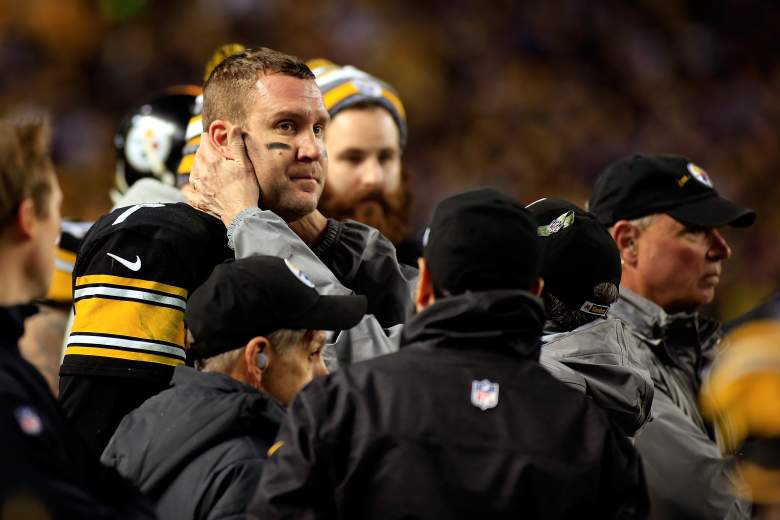
Getty Ben Roethlisberger of the Pittsburgh Steelers is tested for a concussion during a game in 2015
According to findings released Tuesday in The Journal of the American Medical Association, chronic traumatic encephalopathy (CTE) was found in 202 deceased football players, 111 of whom were former players in the NFL. The other players studied played the sport in high school and college.
Conducted by Dr. Ann McKee, a neuropathologist at the VA Boston Healthcare System and director of the CTE Center at Boston University, the study sought to discover what impact playing football had on the brain. Dr. McKee worked from a collection of players organized by a brain donation program and found that of the 111 former NFL players studied, 110 were neuropathologically diagnosed with CTE., an astonishing 99%.
Chronic Traumatic Encephalopathy, according to the study, “is a progressive neurodegeneration associated with repetitive head trauma.” It is most frequently found in the brains of athletes, military veterans and those with a history of experiencing head trauma. Symptoms of CTE are slow to develop, with symptoms usually taking years to appear. Dr. Harrison Martland was the first doctor to notice CTE, when in 1928 he “described a group of boxers as having punch drunk syndrome.” CTE started to become talked about in relation to football in 2005 when Dr. Bennet Omalu, a pathologist, published the the first evidence of the CTE in a player, Mike Webster of the Pittsburgh Steelers. Omalu’s story was made into a movie in 2015, with Will Smith playing Dr. Omalu in Concussion.

Ken Stabler with the Raiders in 1979
Of the players studied by Dr. McKee, those that played on either the defensive or offensive lines suffered the most, with 44 cases of CTE. Running backs ranked second, followed by defensive backs. Not even kickers are immune to CTE, with one place-kicker and one punter appearing in Dr. McKee’s study. The players varied in age, with the youngest being 23 and the oldest being 89. The most well-known player involved was the late Ken Stabler, the beloved quarterback of the Oakland Raiders. Following Stabler’s death in July of 2015, high Stage 3 CTE was discovered in his brain.
Stabler’s family had willingly donated Stabler’s brain to the study, as had most of the players Dr. McKee examined, leading her to warn people reading the study that “there’s a tremendous selection bias.” Brains had been donated because of the suspicion families had prior to their loved one’s death. It should also be noted that the study doesn’t determine exactly how common CTE is among players, nor does it make it clear how many years playing football could lead to a player being diagnosed with CTE.
Yet regardless of the doubt and warnings, the study is solid evidence that playing football does in fact open players up to the risk of developing CTE, something driven home by The New York Times in their reporting.
“C.T.E., which can be diagnosed only after death. About 1,300 former players have died since the B.U. group began examining brains. So even if every one of the other 1,200 players would have tested negative — which even the heartiest skeptics would agree could not possibly be the case — the minimum C.T.E. prevalence would be close to 9 percent, vastly higher than in the general population.”
The NFL had been reluctant to acknowledge a link between playing football and CTE up until 2013, when the NFL reached a financial settlement with former players who were suffering from the disease. Despite the settlement though, NFL owners have remained skeptical of any link between playing football and CTE.
Mike Brown, owner of the Cincinnati Bengals, said in 2014 that he had yet to be “persuaded there is evidence that we totally understand the long-range impact,” but that concussions were a “challenge to the game.” Houston Texans’ owner Bob McNair wanted more information in 2016, saying that “it appears that if you’ve had multiple concussions from whatever you’ve been doing, riding a bicycle, skateboarding, it’s not just football, that there’s a possibility it could lead to CTE.”

Jim Irsay, owner of the Indianapolis Colts, wants the game safe, but not too safe
Jim Irsay, the owner of the Indianapolis Colts, raised eyebrows in March 2016 when he told the Sports Business Journal that owners want a safe game, but they also don’t want “a pillow fight.”
“Obviously we are not going to go to a situation where we put players in almost balloon-like equipment, where it becomes a pillow fight, so to speak. We are trying to look at everything about the safety of the game without changing the game. I believe this: that the game has always been a risk, you know, and the way certain people are. Look at it. You take an aspirin, I take an aspirin, it might give you extreme side effects of illness and your body … may reject it, where I would be fine. So there is so much we don’t know.”
One of the players who were studied by Dr. McKee was Ronnie Caveness, who played linebacker for the Houston Oilers and Kansas City Chiefs and was a college teammate of Dallas Cowboys owner Jerry Jones. Jones has been adamant in his refusal to believe that a link between playing football and developing CTE exists.
In a statement from the NFL, the league said the study is an important one and crucial in terms of learning more about the connection between football and CTE. The NFL added that it “will continue to work with a wide range of experts to improve the health of current and former NFL athletes.”
You can read the entire study HERE.
Comments
A Study of Former NFL Players’ Brains Found 99% Had CTE